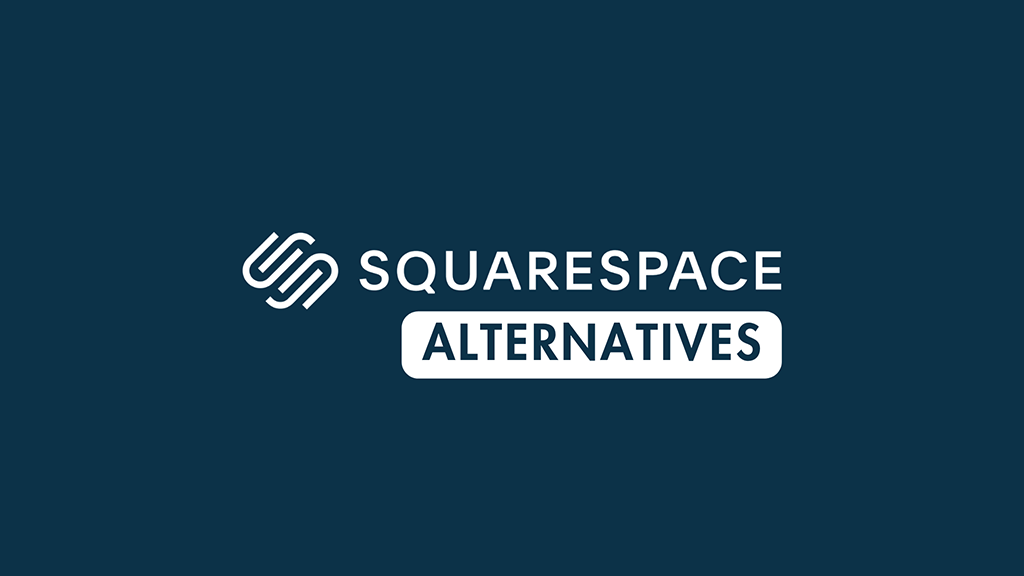
Squarespace is one of our favorite website builders — it’s easy to use, comes with fantastic templates and is a particularly good choice for creative projects. However, it’s not right for every web design project, and in this post we spell out some key Squarespace alternatives to consider.
1. Wix
Wix is perhaps the most obvious alternative to Squarespace.
Like Squarespace, it is aimed mainly at small businesses and solopreneurs, giving users a mix of flexible content presentation tools along with ecommerce features.

The main advantages Wix has over Squarespace involve its:
- ecommerce features — they are considerably more developed, with more options available to users for dropshipping, point of sale (POS) and tax calculation.
- theme selection — there is a much larger selection of customizable templates to choose from (820+ vs Squarepsace’s 160+).
- translation features — while creating multilingual sites with Squarespace involves using a fairly expensive plugin, Weglot, you can translate your site into multiple languages with Wix for free.
- autosave and backup features — while Squarespace doesn’t really give you any, Wix provides built in version history tools.
- free plan — unlike Squarespace, a totally free version of Wix is available. It’s pretty basic in terms of features, and involves fairly prominent Wix advertising, but it is useful in some contexts. You can learn more about this free version of Wix here.
In my view, however, Squarespace is easier to use than Wix — its interface is less cluttered, and it loads features and tools a lot faster (Wix can be a bit sluggish sometimes).
And, significantly, Squarespace templates are fully responsive, meaning they automatically adapt to display correctly on the device they’re being viewed on (mobile, tablet desktop etc.).
By contrast, Wix’s templates use an ‘adaptive design’ approach, which means that you’ll need to build slightly different versions of your site for mobile and desktop devices. While Wix does a pretty good job of creating these automatically for you, some tweaking of your site designs for mobile and desktop is usually necessary.
Google favors responsive design too, so if you’re working in an extremely competitive niche, you may benefit from slightly preferential treatment in search results by using Squarespace. For most users, this shouldn’t be a massive concern however — a good placement in search results relies on many factors, including good keyword research, strong content and high-quality backlinks. Sites built with Wix can and do rank highly in search results.
To learn more about the key differences between Wix and Squarespace, you can check out our video comparison of the two platforms below, or read our Wix vs Squarespace comparison here.
2. Shopify
If selling online is your main aim, and you want to use an all-in-one hosted solution to do so, then Shopify is arguably the best alternative to Squarespace.
This is because it lets you sell products in just about any way imaginable — whether that’s via an online store, at point of sale or via an extensive range of dropshipping suppliers. The ecommerce features in Squarespace, while functional and easy to use, are pretty basic by comparison to Shopify’s.
In particular, Shopify is a much better solution for international selling than Squarespace — unlike the latter, it facilitates automatic currency conversion and lets you translate your store into multiple languages easily (as discussed above, translating a Squarespace site usually involves paying for a separate translation app, Weglot).
Shopify also gives you excellent free email marketing tools, while Squarespace charges you extra for them.

Squarespace remains the better choice however for content-related applications — its excellent and flexible drag and drop editor beats Shopify’s; and it lets you create stunning galleries, slideshows, data capture forms and other content blocks out of the box (doing so in Shopify often requires the installation of paid-for apps).
Shopify can get expensive though, with its premium plans ranging from $39 to $399 per month (the most expensive Squarespace paid plan is $65 per month). Additionally, Shopify doesn’t give you a free domain when you pay for your subscription on an annual basis.
To learn more about the differences between these two platforms, make sure you read our full Shopify vs Squarespace comparison.
3. WordPress
WordPress is available in two versions: hosted and self-hosted. The hosted version is, like Squarespace, a browser-based product that gives you a range of built-in, easy-to-use website building features.
Either version of WordPress is better than Squarespace if blogging is the key part of what you’re doing — Squarespace’s blogging features are definitely on the basic side by comparison to Wordpress’ (Squarespace doesn’t give you version history or autosave features, or the option to install the excellent Yoast SEO tool).
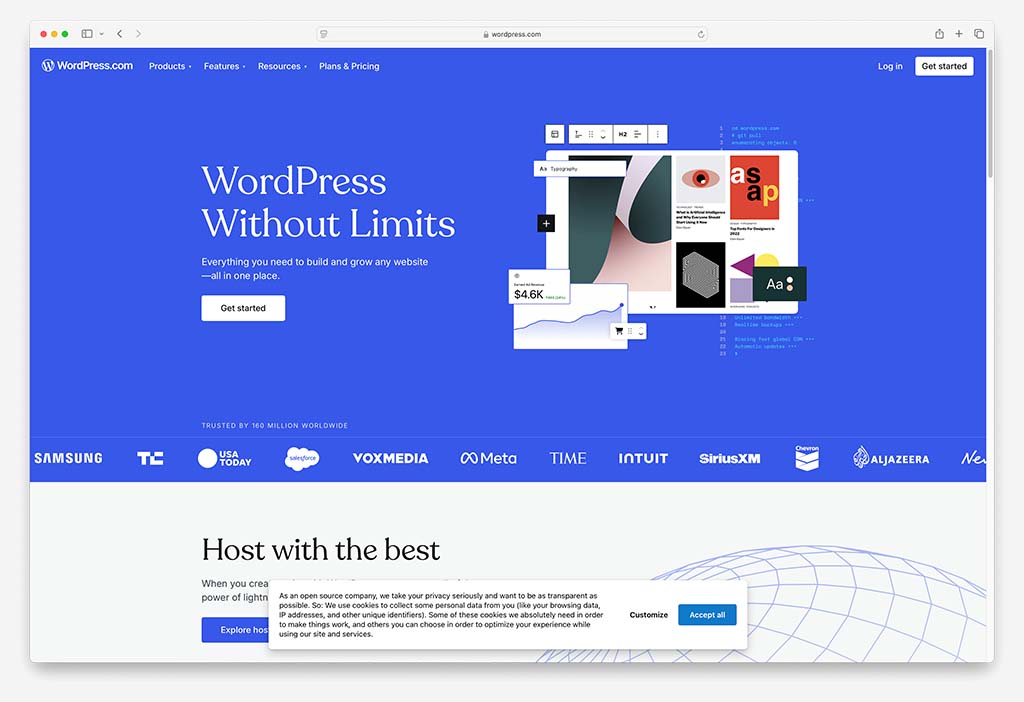
On the more expensive hosted WordPress plans, you get selling features provided via WooCommerce, a very well-specced ecommerce tool that gives you considerably more selling features than Squarespace’s ecommerce system.

Merchants who are serious about ecommerce usually opt for the hosted version of WordPress, though. This is an open source version of the platform that you download for free and install on your own hosting.
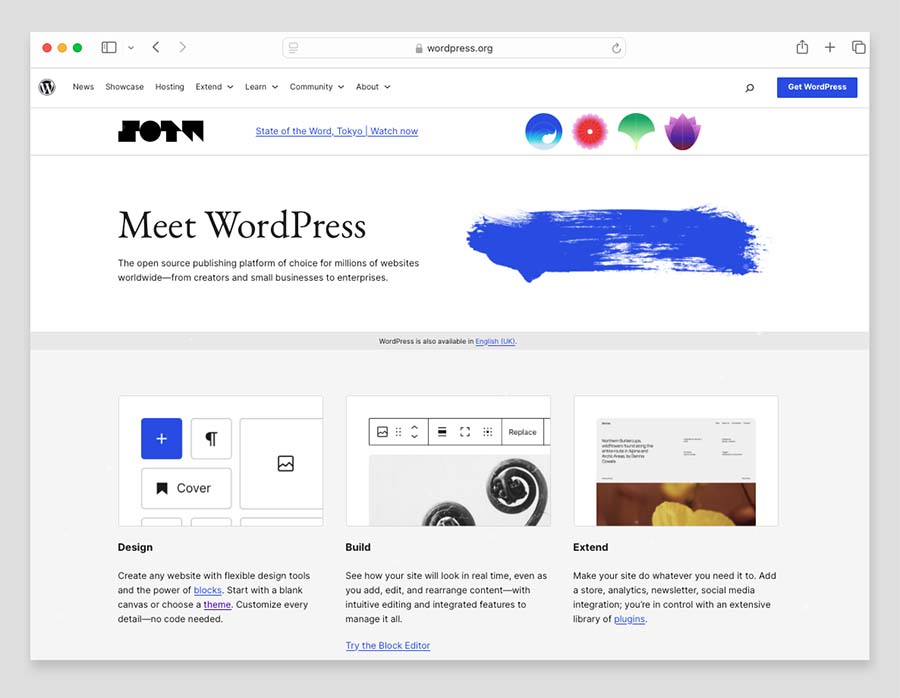
The advantage of using self-hosted WordPress over Squarespace is that you have absolute control over everything.
You can:
- pick the ecommerce tool you’d like to use (WooCommerce, Ecwid, Easy Digital Downloads etc.)
- code any features you like into your site
- configure your technical SEO settings exactly the way you want them
- choose your own web hosting — you’re not restricted to using a platform’s default hosting but can install WordPress on a preferred, super-fast web hosting service
- make use of a much wider range of themes and plugins than Squarespace.
The disadvantage of using self-hosted WordPress over Squarespace is more setup time and configuration, plus a steeper learning curve.
And, if you are serious about getting the most out of WordPress from a PageSpeed and technical SEO perspective, there’s often some quite expensive hosting involved and (depending on your own technical skills) development work to pay for.
On top of that, regular maintenance and software updates are usually needed to keep a WordPress site secure.
You don’t have to worry about any of that with Squarespace.
4. Square Online
Square Online started out as a point-of-sale (POS) solution for accepting in-person transactions (i.e., in ‘brick and mortar’ stores). But with the acquisition of the website building tool Weebly, whose technology the platform now incorporates, it has evolved into a solution that lets you build websites and ecommerce stores too.
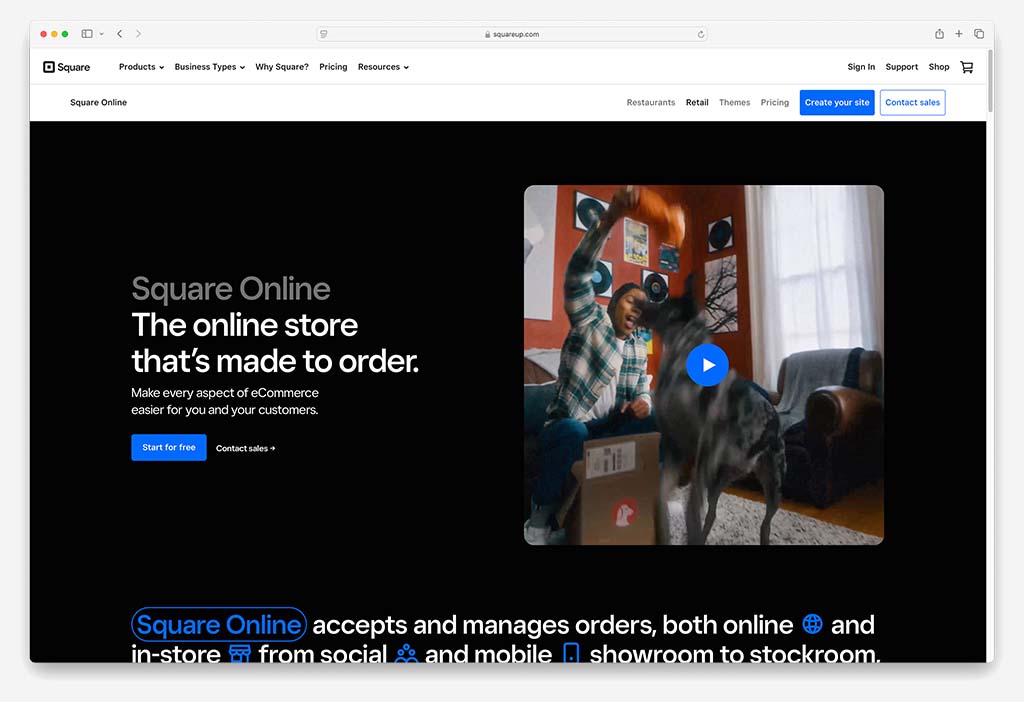
The Square Online website builder is similar in quality to Squarespace, but it does have a key advantage over it, in that it can be used entirely for free (albeit with several important features missing).
The other reason you might want to opt for Square over Squarespace is if you need high-quality point of sale features — given its heritage, Square offers some very strong POS features.
And, as with its website building tool, Square’s POS system can be used for free — you just pay transaction fees on a per-sale basis.
To use POS with Squarespace however, you will always need to pay for a monthly subscription to the platform, and you’ll end up using Square anyway (as Square powers Squarespace’s POS option). The other thing to note about Squarespace and POS is that the feature is only currently available in the US.
It’s worth noting that Square places a particular focus on restaurant owners, and accordingly comes with special features that make running food and drink businesses easier (for example, table management, tipping and loyalty card functionality).
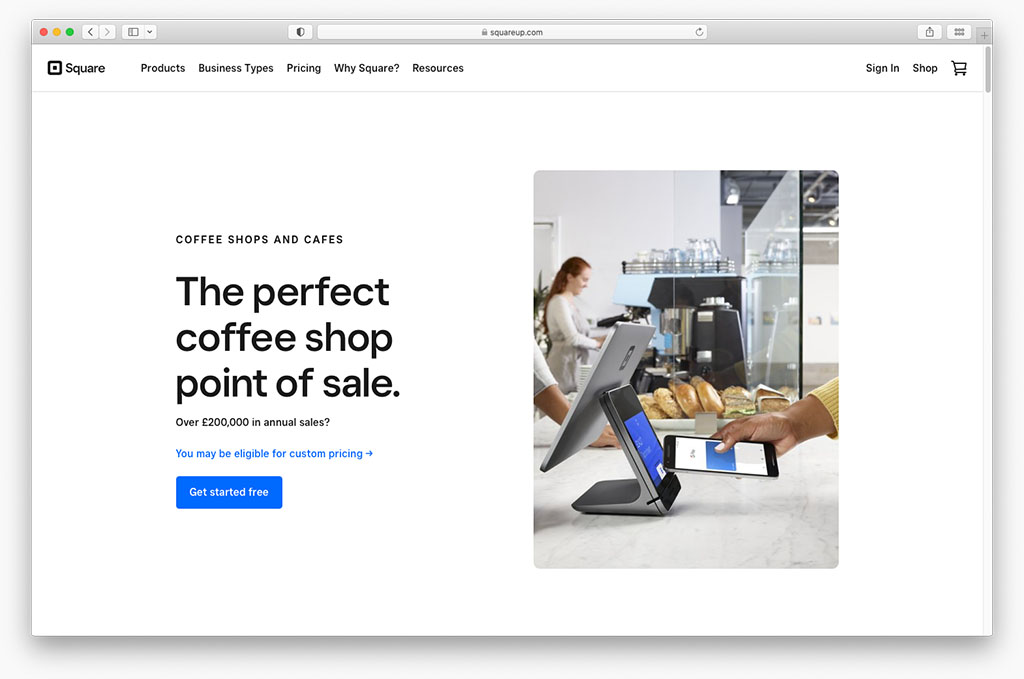
So, if you own a restaurant or a take-out business, you may find Square to be a much more ‘natural’ fit than Squarespace.
5. Webflow
Webflow is typically used as a solution for creating extremely ‘bespoke’ websites that make heavy use of animations and interactive features.

The main reason you might want to use Webflow instead of Squarespace is if you want to control your template design to the nth degree, or build an animation-heavy website — while Squarespace is a very ‘templated’ solution, you can create truly unique designs with the controls provided by Webflow.
(These designs are exportable too — so you can craft a site design in Webflow and host it wherever you like; this isn’t possible with Squarespace).
Webflow is also better from a version history point of view — it autosaves and backs up your content, while Squarespace doesn’t.
Additionally, Webflow beats Squarespace when it comes to creating tables — it provides an integrated table builder; Squarespace doesn’t let you use tables at all.
Squarespace is definitely the easier platform to use however, and if you’re new to web design, you’ll find it much simpler to put a professional website together with.
You can learn more about Webflow in our Webflow review, or find out more detail about how it stacks up against Squarespace in our Webflow vs Squarespace comparison.
Free ecommerce kit 🖥️💰
While you’re here, check out our free ecommerce kit. It’s packed with useful resources on setting up an online business, along with trials and offers for popular ecommerce apps.
6. BigCommerce
BigCommerce can be a good alternative to Squarespace.
Like its key rival Shopify (discussed above), BigCommerce is a platform that was designed specifically with ecommerce in mind — and accordingly, boasts a similar range of sophisticated selling tools that you won’t find in Squarespace (multicurrency conversion, more advanced tax calculation features, better ecommerce analytics, more payment gateways, more dropshipping apps etc.).

However, BigCommerce’s drag and drop editor is not yet as good as Squarespace’s; its template range is much more limited; and it’s not as user friendly.
So as with Shopify, BigCommerce can be a really strong alternative to Squarespace — but only if your focus is 100% on ecommerce. If your aim is to create a content site and do some simple selling on the side, then Squarespace usually remains the better option.
You can learn more about the key differences between Squarespace and BigCommerce in our comparison review of the two platforms.
7. Big Cartel
Big Cartel is a website and online store builder that was originally built to facilitate sales of ‘creative’ products — music, painting, jewellery etc. It still retains this focus on artists and makers, but it is increasingly used by other small business types too.

From a features perspective, Big Cartel is not remotely as sophisticated as Squarespace (particularly when it comes to content management and presentation, SEO, dropshipping, point of sale and abandoned cart saving features).
It does however offer a few advantages over Squarespace:
- It can be used for free (so long as you are selling less than 5 products)
- Its paid-for plans are much cheaper than the Squarespace equivalents
- It’s extremely easy to use — the learning curve is minimal.
Professional merchants will ultimately fare much better with Squarespace (or one of the other ecommerce solutions discussed above), but artists and musicians on a low budget (or without a budget at all) will really appreciate the low-cost, no-frills nature of Big Cartel.
You can learn more about the platform in our Big Cartel review.
8. GoDaddy Website Builder
GoDaddy Website Builder is a popular website building platform that like Squarespace gives you a good range of basic content management and ecommerce features out of the box.
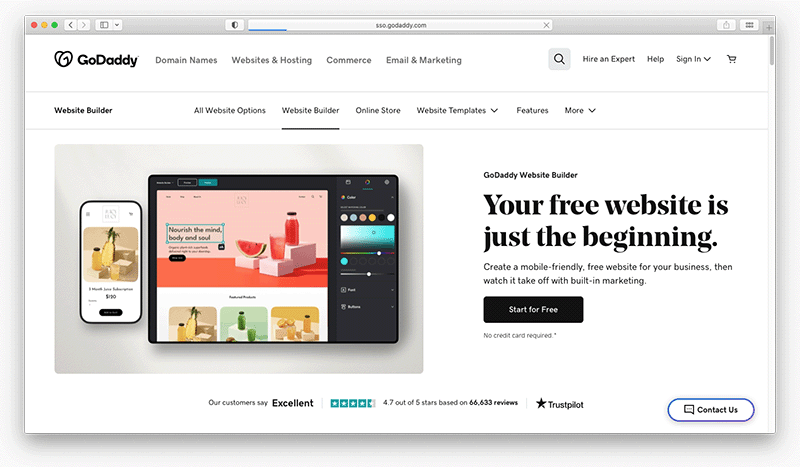
There are a few reasons why you might want to consider it instead of Squarespace:
- It lets you sell larger digital files (up to 20GB in size — Squarespace limits you to selling 300MB downloads).
- It bundles generous email marketing tools with its plans, while Squarespace requires you to pay extra to access email marketing features.
- It gives you tools for creating GDPR-compliant cookie banners out of the box (while Squarespace doesn’t).
The main reason for choosing Squarespace over GoDaddy involves its more sophisticated content management system — its drag and drop editor is considerably better than the GoDaddy equivalent. You can also make use of a lot more typefaces in Squarespace, which helps considerably from a branding perspective.
We don’t yet have a direct comparison of Squarespace and GoDaddy available, but our Shopify vs GoDaddy comparison and Wix vs GoDaddy comparison may be of use in helping you get a better sense of the pros and cons of the GoDaddy platform.
9. Ecwid
Ecwid started out as a widget for adding ecommerce to any site (hence the name: ‘Ec-wid’). And that remains its main focus — Ecwid gives you a snippet of code that you insert on your site, which then adds a comprehensive range of selling features to it.

In recent years Ecwid also added a new ‘Instant Site’ feature that lets you create simple but attractive stores that can live on a custom domain (yoursitename.com etc.). Now, these are by no means as fully-featured or sophisticated as Squarespace standalone store — and can only contain a few pages — but they are extremely fast and easy to create.

The main advantage that Ecwid provides over Squarespace however involves pricing: the platform can actually be used entirely for free.
Ecwid’s free plan is basic though — it limits you to selling 5 products, and only via your own online storefront (i.e., rather than on Facebook, Amazon etc.). But that might be enough for some site owners.
Overall, Ecwid can be a better choice than Squarespace if…
- you’re on a very low budget and really need a free selling option
- you’re more interested in adding ecommerce to an existing website than creating a brand new one.
If your aim is to build a brand new standalone website though — and particularly one that is focused on showcasing high quality content — Squarespace is definitely the more professional choice.
Check out our Ecwid review for some more details on the platform, or watch the video below for a summary of its key pros and cons.
10. Canva
Given that Canva is generally considered to be a user-friendly graphic design and video editing tool and not a website builder, I’ll admit that including it in our list of Squarespace alternatives may seem a little bit leftfield.
However, if your web design needs are extremely simple, Canva can actually work as a good Squarespace alternative.
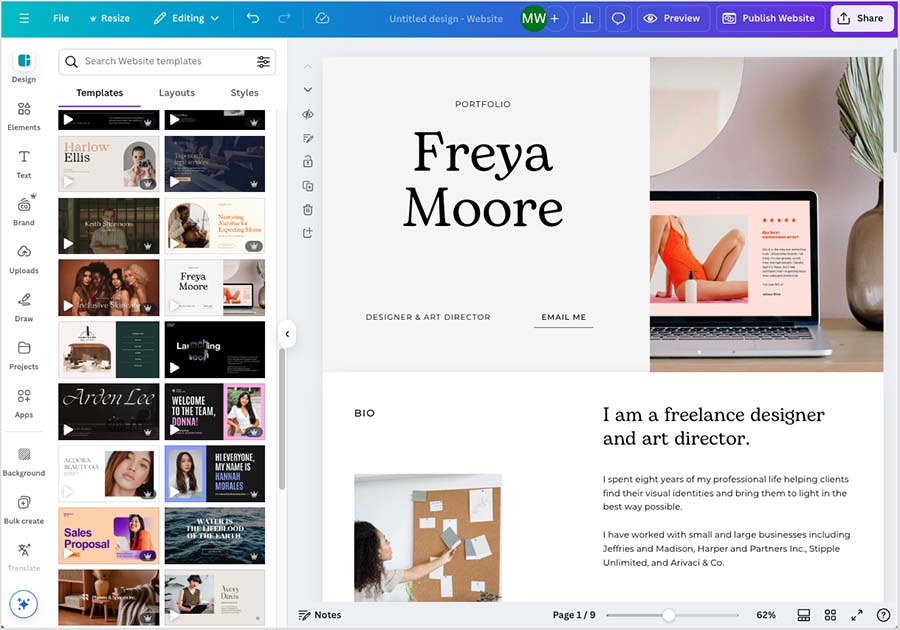
This is because in addition to letting you create visuals and videos, Canva gives you a website building feature.
Now, it has to be said that this is an extremely simple tool that lets you build one-page sites only — but if all you need is a simple portfolio or resume site, it’s really quite good.
There are two advantages of using Canva over Squarespace. One is price: it’s considerably cheaper. The other is the range of other features it gives you in addition to a website builder — a presentation maker, video editor, drawing tool, document editor etc. These are all extremely valuable tools for any business — and they’re extraordinarily easy to use.
However, if you plan on doing any online selling or blogging, or need a multi-page website, Squarespace is a much better choice.
And don’t forget online marketplaces: Amazon, Etsy and eBay
Given that many people are interested in Squarespace because of its selling features, a lot of the Squarespace alternatives I’ve highlighted above are solutions that let you build a standalone store.
Online marketplaces like Amazon, Etsy and eBay differ from these, because they ARE online stores — and huge ones at that.
But you can still use them to sell products on, and the main advantage of doing this rather than using Squarespace for ecommerce is that you are gaining access to ready-made, large audiences of people who want to buy things.
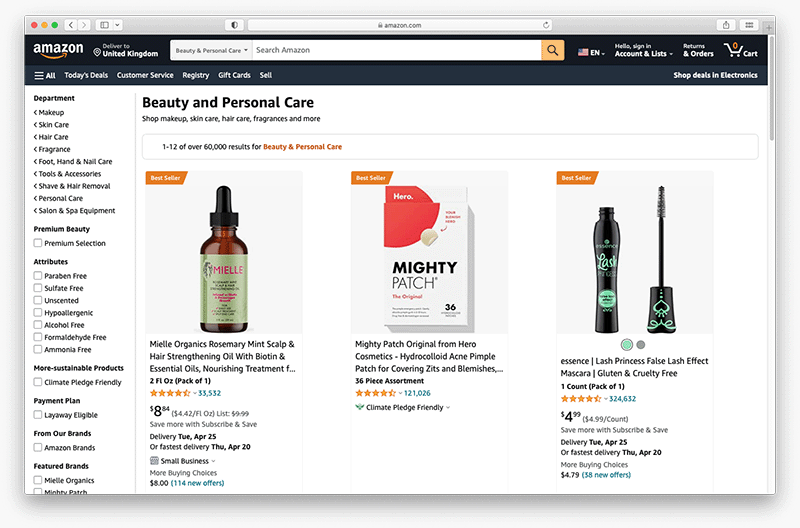
By contrast, when you set up a Squarespace store, its up to you to find an audience for it (via blogging, SEO, online advertising etc.).
The other advantage of using online marketplaces instead of Squarespace is that you don’t have to worry that much about web design tasks — domain registration, graphic design, navigation design, UX, copywriting and so on. With the likes of Amazon, eBay and Etsy, you’re just listing your products on an existing website — not building an entirely new one.
(Note: Etsy actually offers a standalone online store builder called ‘Pattern’ — this integrates smoothly with Etsy and can work well as a ‘best of both worlds’ solution for some merchants. However, it should be noted that Pattern’s selling features are pretty basic, and merchants who want an online store AND a presence on Etsy might be better advised to use a Shopify store in conjunction with Etsy listings. See our Shopify vs Etsy post for more details on doing this).
The downsides of using all these marketplaces over Squarespace are that you have far less control over your brand and less opportunities for content marketing; additionally, they aren’t great for dropshipping.
Some other Squarespace alternatives to consider
The website builder market is big — and growing fast!
Some other Squarespace competitors that you might wish to consider include:
- ClickFunnels
- Duda
- Gater (by HostGater)
- IONOS
- Jimdo
- Pixpa
- Strikingly
- Volusion
- Webnode
And if you have any questions on these (or any of the Squarespace competitors discussed in this post) do leave a comment and we’ll get back to you.
Squarespace alternatives FAQ
Below you’ll find some frequently asked questions about competitors to Squarespace.
Who are Squarespace’s main competitors?
When it comes to hosted online website builders, the main competitors in terms of userbase size and features are probably hosted WordPress (WordPress.com), Wix and Shopify.
Is Squarespace the best website builder?
It’s one of the best – it’s extremely easy to use, comes with excellent templates and has a fairly comprehensive feature set. The main criticism of Squarespace is that its ecommerce features are a bit underpowered, especially where international selling is concerned.
Is Squarespace free?
No — although a free trial of the platform is available, you’ll have to pay a subscription fee to use it on an ongoing basis.
Are there any free alternatives to Squarespace?
Yes — key competing product Wix has a free plan, and two key competing ecommerce platforms that you can use entirely for free are Big Cartel and Ecwid. However, these free plans are very basic; in the case of Wix, the free version features a lot of advertising and doesn’t let you use ecommerce features. And the free versions of Big Cartel and Ecwid limit you to selling just a few products.
What are the main advantages of Squarespace?
The main advantages of Squarespace are that it’s easy to use, it comes with beautiful templates and its content management system is highly flexible.
What are the main disadvantages of Squarespace?
The main disadvantages of Squarespace are that it lacks multi-currency selling features, it doesn’t let you translate much content without paying for a third-party app and it isn’t great for point of sale applications.
📚 Related resources: Shopify alternatives, Webflow alternatives, Wix alternatives
No comments